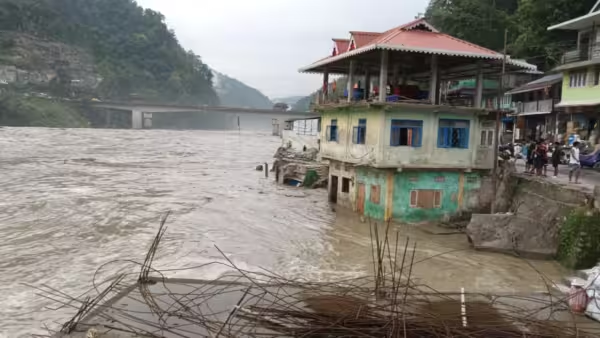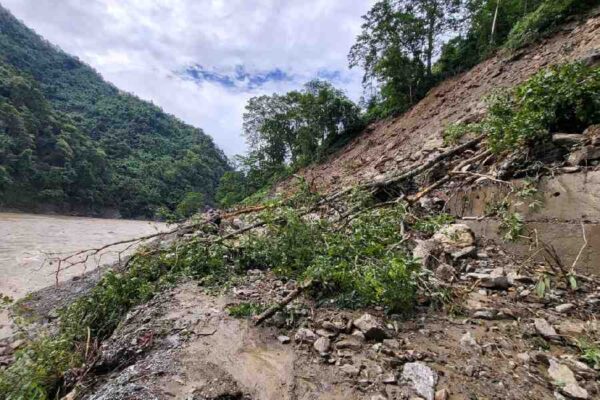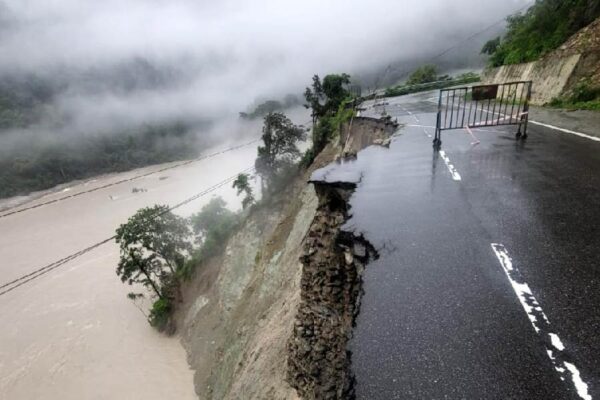The hills of Kalimpong and Sikkim which were once known for their scenic beauty and tranquility, are now in the news for far more concerning reasons. Climate change is exerting significant pressure on these regions, causing residents to struggle to adapt to shifting weather patterns and unprecedented disasters, particularly during the monsoon season. The situation in the hills of Kalimpong and Sikkim has become even more difficult ever since the Glacial Lake Outburst Flood (GLOF) in 2023. This catastrophic incident destroyed the 1,200 MW Teesta Stage III and triggered widespread flooding downstream. The flooding also severely impacted the National Highway-10 (NH10) – a vital link between these hills and the rest of the country – leaving large parts of West Bengal and Sikkim isolated and cut off from essential services. (To know more about hydropower threats in the Indian Himalayas, you can read my article here)
Residents of these Himalayan hills, who were already struggling with limited infrastructure and fragile ecosystem, are now facing the increasing wrath of landslides and flash flooding from the Teesta River. Locals affirm that since the GLOF incident, the Teesta River, which was once a relatively calm mountain river, has shown dramatic changes in its behavior. During the monsoon of 2024, residents observed the river becoming unusually volatile and destructive; torrential rains, which had never severely affected the river before, caused the Teesta to rise dramatically and flood nearby areas such as Teesta Bazaar while leaving behind a trail of devastation.

This situation is even more heartbreaking for villagers living alongside the river. Many had invested their life savings into building their homes, only to be forced to evacuate and watch helplessly as the soaring river flooded and swept away everything they had worked for. The lower-income communities, especially those who already had limited means of earning a livelihood, are now struggling with the overwhelming financial and emotional burden of rebuilding, all while knowing they face the same risk again when the next monsoon arrives.
Furthermore, these incidents have also placed a heavy burden on transportation and connectivity between Sikkim and Kalimpong and the rest of the country. NH10, as mentioned earlier, serves as a vital lifeline connecting Kalimpong and Sikkim to the rest of the country. However, during the heavy downpours of the 2024 monsoon, frequent landslides and flash flooding of the Teesta River repeatedly disrupted traffic on the highway. In fact, for the first time ever, Kalimpong was left stranded with all its routes either being blocked by landslides or being deemed too dangerous to use.

It is also important to highlight that this isolation not only disrupts the traffic flow but can also hinder critical services, including medical emergencies. For example, Kalimpong being a small town lacks advanced healthcare facilities, meaning in many cases patients in critical conditions often need to be referred to more advanced hospitals in cities like Siliguri and Kolkata. It is therefore important to emphasize that these disruptions not only affect the traffic flow but can also endanger the lives of people as they struggle with timely access to necessary medical care.
Way Ahead?
With several infrastructure projects such as hydropower plants and railway expansions ongoing along NH10, it is essential that these developments incorporate effective and resilient planning. While these projects are vital for the region’s growth, it is imperative to implement them in a thoughtful and responsible manner. Additionally, proper adaptation planning must be prioritized. Some key strategies include:
Comprehensive Mitigation Strategies: It is essential to prioritize the establishment of comprehensive mitigation strategies and to conduct thorough Environmental Impact Assessments (EIAs) for both ongoing and future infrastructure projects. These assessments should aim to identify and address potential hazards. For example, the 2023 GLOF incident highlighted that for the Teesta Stage III project, multiple risks were recognized, however the identified risks were not adequately assessed nor was a proper mitigation strategy implemented. This underscores the importance of learning from past mistakes. If possible, an independent body of experts from the Himalayan region should be established and consulted for major environment related decisions to ensure localization of knowledge and expertise thereby fostering trust within communities.
Infrastructure Resilience: As highlighted in previous sections, landslides and floods pose significant challenges, making it crucial to upgrade existing infrastructure to withstand climate impacts. This includes reinforcing roads and bridges, to cope with increased rainfall and landslides. The repetitive landslides and flooding also highlights the necessity of constructing and installing culverts and stone walls based on the latest flood and landslide hazard mapping. Furthermore, all major infrastructure projects should prioritize climate resilience in their designs. Lastly, establishing a highly functional early warning system is extremely important, particularly given the insufficient emphasis placed on early warning systems in disaster preparedness, as highlighted by the 2023 GLOF incident.
Adaptation Funding and Resource Allocation: It is extremely important that government dedicatedly allocates increased funds towards adaptation efforts in these hilly regions of West Bengal and Sikkim. These funds can be focused on various aspects, including upgrading existing infrastructure to build climate resilience, supporting and encouraging community-based adaptation initiatives, organizing workshops and capacity building programs for disaster preparedness and for monitoring and evaluation of these adaptation strategies.
With the ever-changing climate and the increasing threats of landslides and flooding in the hills of Kalimpong and Sikkim, the fragility of the region’s infrastructure and ecosystems can be highlighted. It is extremely vital that these challenges are addressed, as every passing monsoon becomes increasingly dangerous for the residents of these Himalayan hills.
Building proper mitigation strategies, enhancing infrastructure, and establishing a robust financial flow for adaptation efforts in these regions is the need of the hour. It is also important that all level of stakeholders – government, local communities, municipalities and environmental experts — must come together for a collective effort to safeguard the hills and their residents. The time for action is now and cannot be postponed, as the looming threat of another catastrophic event grows ever closer.

